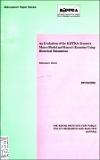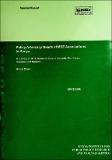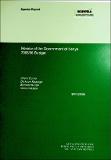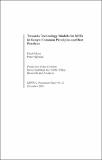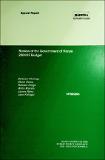3. KIPPRA Research Publications: Recent submissions
Now showing items 601-620 of 709
-
Discussion Paper No. 59 of 2006 on an Evaluation of the KIPPRA-Treasury Macro Model and Kenya's Economy Using Historical Simulations
(The Kenya Institute for Public Policy Research and Analysis, 2006)Model simulations are perfonned for different reasons, such as policy evaluation, historical policy analysis and model testing. Ex ante simulations tend to be more popular, particularly for the purposes of evaluating ... -
Discussion Paper No. 61 of 2006 on Determinants of Seed Maize Pricing in Kenya
(The Kenya Institute for Public Policy Research and Analysis (KIPPRA), 2006)Kenya has been experiencing declining use of certified seed maize. About 30 percent of Kenyan maize farmers use either traditional seeds or recycled hybrids, mainly due to high cost of certified seed maize and other inputs. ... -
Occasional Paper No. 06 of 2006 on State-Private Sector Nexus in National Wealth Creation: A Framework for Analysis and its Application to Kenya
(The Kenya Institute for Public Policy Research and Analysis, 2006)This study discusses a theoretical framework that is used to explore the interaction between the state and private sector. Three classes of businesses are identified, namely: makers or producers; traders/merchants or ... -
Special Paper No. 07 of 2006 on Private Sector Investment in Education and Training: A Case of Tertiary Education in Kenya
(The Kenya Institute for Public Policy Research and Analysis (KIPPRA), 2006)This paper assesses the current status of private sector participation in education investment and makes policy recommendations. A cross-sectional research design was used in this study. An in-depth descriptive analysis ... -
Special paper No. 08 of 2006 on Policy Advocacy Needs of MSE Associations in Kenya
(The Kenya Institute for Public Policy Research and Analysis (KIPPRA), 2006)This study relates to one of the components of a three-year USAID-supported project on "Enhanced Policy Formulation and Implementation for Micro and Small Enterprises - MSEs" as proposed and implemented by KIPPRA (2003). ... -
Special Paper No.10 of 2006 on Review of the Government of Kenya 2005/06 Budget
(The Kenya Institute for Public Policy Research and Analysis (KIPPRA), 2006)The review of the Government of Kenya 2005/06 budget sought to ascertain how the annual budget allocations traced the broad fiscal and macroeconomic targets set out in the Economic Recovery Strategy for Wealth and ... -
Working Paper No. 14 of 2006 on Development Finance Institutions in Kenya: Issues and Policy Concerns
(The Kenya Institute for Public Policy Research and Analysis (KIPPRA), 2006)Development Finance Institutions (DFIs) in Kenya were set up to provide longterm finance to prioritized sectors as part of the industrialization strategy. Despite the existence of DFIs since the 1960s and 1970s, there ... -
Conference Proceeding No. 03 of 2005 on Urban and Regional Planning as an Instrument for Wealth and Employment Creation
(The Kenya Institute for Public Policy Research and Analysis, 2005)According to estimates by the UN-Habitat, nearly 50% of the population in developing countries will be urban by the year 2020 as more people abandon traditional rural areas to live and work in cities. In Kenya, as in ... -
Working Paper No. 12 of 2005 on Kenya's Reform Experience: What Have We Learnt?
(The Kenya Institute for Public Policy Research and Analysis (KIPPRA), 2005)Kenya has since independence from Britain in 1963 undergone a number of political and economic phases. Like most African countries, Kenya's economy in the 1960s and 1970s was characterised by controls and a protective, ... -
Discussion Paper No. 51 of 2005 on Towards Technology Models for MSEs in Kenya: Common Principles and Best Practices
(The Kenya Institute for Public Policy Research and Analysis (KIPPRA), 2005)Global business pressures generated by globalization and liberalization have shifted emphasis from traditional factors of competitiveness (such as price reductions) towards new forms of competitiveness (such as innovation ... -
Discussion Paper No. 53 of 2005 on Misallocation of Workspaces for MSEs in Kenya: Lessons and Models
(The Kenya Institute for Public Policy Research and Analysis, 2005)One of Kenya’s development goals is to provide an enabling environment for both local and foreign investors. An important element of such an environment is the physical infrastructure especially land and workspaces. An ... -
Discussion Paper No. 48 of 2005 on Institutional Factors and Foreign Direct Investment Flows: Implications for Kenya
(The Kenya Institute for Public Policy Research and Analysis, 2005)This study looks at the relationship between Foreign Direct Investment (FDI) flows and various institutional factors. The study uses data for developing countries and draws implications for Kenya. Kenya has in the last ... -
Discussion Paper No. 47 of 2005 on Growth of the Nairobi Stock Exchange Primary Market
(The Kenya Institute for Public Policy Research and Analysis, 2005)The study explores the development of the Nairobi Stock Exchange primary market since its inception in 1953. To understand the factors influencing growth of the market, the study uses a historical perspective approach. ... -
Discussion Paper No. 54 of 2005 on Heavy Commercial Vehicles Industry in Kenya: Regulation or Deregulation?
(The Kenya Institute for Public Policy Research and Analysis, 2005)This paper assesses the current regulatory framework in the heavy commercial vehicles industry sub-sector. The transport sector constitutes a major component of the services sector in Kenya and has a big potential as one ... -
Discussion Paper No. 52 of 2005 on Implicit Taxation of Agricultural Sector in Kenya
(The Kenya Institute for Public Policy Research and Analysis, 2005)Over the years, a number of policies have been designed and implemented to ensure agriculture continues to play an important role in economic development. This paper discusses the policies that have guided the ... -
Discussion Paper No. 50 of 2005 on Child Healthcare Seeking Behaviour in Kenya
(The Kenya Institute for Public Policy Research and Analysis, 2005)Although child healthcare receives enormous attention from governments, households and international organizations in developing countries, the economics of child healthcare in Kenya remain unexplored, denying this ... -
Discussion Paper No. 49 of 2005 on Review of Policy Options for Poverty Reduction in Kenya
(The Kenya Institute for Public Policy Research and Analysis, 2005)Poverty in Kenya is caused by a number of factors, which include low agricultural productivity and poor marketing of industrial and agricultural products, insecurity, unemployment and low wages, poor governance, misallocation ... -
Special Paper No. 09 of 2005 on Review of the Government of Kenya 2004/05 Budget
(The Kenya Institute for Public Policy Research and Analysis (KIPPRA), 2005)The budget for fiscal year 2004/ 05 is the second budget in the implementation of the Economic Recovery Strategy for Wealth and Employment Creation (ERSWEC) 2003-2007 and fourth under the Medium Term Expenditure Framework ... -
Working Paper No. 13 of 2005 on Tax Reform Experience in Kenya
(The Kenya Institute for Public Policy Research and Analysis (KIPPRA), 2005)Counties all over the world have reformed or are attempting to reform their tax systems, with the main impetus being the increasing complexity of tax codes, narrow tax bases, and concerns with horizontal equity. Kenya's ... -
Policy Brief No. 02 of Sept.2004 on Fiscal Strategies and Poverty in Kenya: Agenda for Reform
(The Kenya Institute for Public Policy Research and Analysis (KIPPRA), 2004-09)This policy brief is based on a study: Fiscal strategies and poverty in Kenya: Agenda for reform. The study examines how the government spends and finances its expenditure, and how this has impacted on poverty and ...

